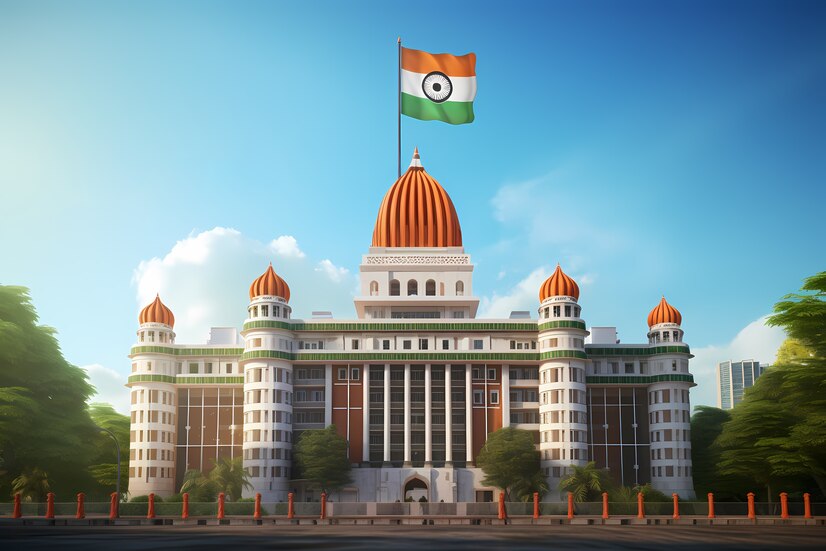Introduction
The Indian Parliament stands as the cornerstone of the world’s largest democracy, embodying the will of its billion-plus inhabitants. It orchestrates the symphony of governance, lawmaking, and oversight, ensuring the nation’s democratic ethos and constitutional mandate are upheld. Tracing its roots back to the pre-independence era, the Parliament has evolved, mirroring the aspirations and challenges of a diverse and dynamic India.
The Bicameral Structure
India’s Parliament is a bicameral legislature consisting of the President, the Lok Sabha (House of the People), and the Rajya Sabha (Council of States). The Lok Sabha represents the voice of the people, directly elected to reflect the democratic mandate. On the other hand, the Rajya Sabha represents the states of the Indian federation, with its members elected by the state legislative assemblies. This dual structure balances the principle of population-based representation with that of equitable state representation, ensuring a comprehensive legislative review process.
Legislative Process
The legislative procedure is the heartbeat of parliamentary function, where proposed laws (bills) are debated, scrutinized, and either adopted or rejected. The process begins with the introduction of a bill, followed by various stages including discussion, committee review, and voting. Money Bills, which pertain to the country’s finances, must originate in the Lok Sabha and have a special procedure underscoring the lower house’s primacy in financial matters.
Parliamentary Functions
Beyond lawmaking, Parliament exercises financial oversight, ensuring that taxpayers’ money is allocated and spent responsibly. Through mechanisms like the Question Hour and Zero Hour, it holds the government accountable, questioning policies and decisions. Debates and discussions on national and international issues also take place within its halls, reflecting the country’s diverse perspectives and shaping its policy directions.
Parliamentary Committees
The work of Parliament is supported by various committees, which include Standing Committees, Select Committees, and Joint Committees. These committees delve deeper into issues, scrutinize bills and policies, and make recommendations. Their work is crucial for detailed legislative review and informed decision-making, allowing for a more nuanced examination of matters than what is possible in the broader parliamentary debates.
Challenges and Reforms
Despite its pivotal role, the Indian Parliament faces challenges like frequent disruptions, a declining number of sitting days, and the passage of bills without adequate debate. These issues hamper its efficiency and the quality of democratic deliberation. Recent reforms aim to address these problems, including the introduction of the Productivity Index of Parliament sessions and efforts to increase transparency and public engagement. However, more needs to be done to enhance parliamentary effectiveness and uphold the sanctity of this institution.
Conclusion
In conclusion, the Indian Parliament plays a vital role in governing the nation and upholding democracy. With its bicameral structure, legislative processes, and oversight functions, it ensures representation and accountability. Despite facing challenges, efforts are underway to improve efficiency and transparency. Moving forward, it is essential to continue strengthening the Parliament to maintain its significance in shaping India’s future.
FAQs
1. What is the Indian Parliament?
The Indian Parliament is the supreme legislative body of the country, responsible for making laws, overseeing the government, and representing the people.
2. How is the Indian Parliament structured?
The Indian Parliament is bicameral, consisting of two houses: the Lok Sabha (House of the People) and the Rajya Sabha (Council of States), along with the President of India.
3. What is the role of the Lok Sabha?
The Lok Sabha is the lower house of Parliament and represents the people of India. Its members are elected through direct elections, and it has the primary responsibility for lawmaking and financial matters.
4. What is the role of the Rajya Sabha?
The Rajya Sabha is the upper house of Parliament and represents the states and union territories of India. Its members are elected by the state legislatures, and it plays a crucial role in reviewing and amending legislation proposed by the Lok Sabha.
5. How are bills passed in the Indian Parliament?
Bills can be introduced in either house of Parliament, but they must be passed by both houses and receive the President’s assent to become law. The legislative process involves several stages of debate, scrutiny, and voting.
6. What are the functions of the Indian Parliament?
The Indian Parliament performs various functions, including lawmaking, financial oversight, questioning the government, and debating national and international issues.
7. What are parliamentary committees, and what do they do?
Parliamentary committees are smaller groups of members from both houses tasked with examining specific issues, scrutinizing bills, and making recommendations. They play a crucial role in detailed legislative review and oversight.
8. What challenges does the Indian Parliament face?
The Indian Parliament faces challenges such as disruptions, declining sitting days, and the passage of bills without adequate debate, which can affect its efficiency and effectiveness.
9. What reforms are being undertaken to improve the functioning of the Indian Parliament?
Efforts are underway to address challenges and improve parliamentary efficiency, including introducing productivity measures, increasing transparency, and enhancing public engagement.
10. How important is the Indian Parliament to Indian democracy?
The Indian Parliament is essential for upholding democratic principles, ensuring representation, accountability, and governance in the country. It serves as a cornerstone of India’s democratic system.





